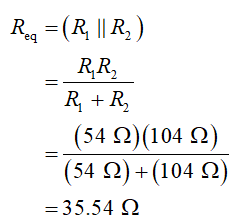The following circuit has a bulb of resistance 54 N attached to a source 18 V. What must be the current through the source if another lamp of resistance 104 Q is added in parallel with the the first one? Give answer in amperes with two decimal place.
The following circuit has a bulb of resistance 54 N attached to a source 18 V. What must be the current through the source if another lamp of resistance 104 Q is added in parallel with the the first one? Give answer in amperes with two decimal place.
Related questions
Question
4//

Transcribed Image Text:The following circuit has a bulb of resistance 54 N attached to a source 18 V. What
must be the current through the source if another lamp of resistance 104 Q is
added in parallel with the the first one? Give answer in amperes with two decimal
place.
Expert Solution
Step 1
Equivalent resistance

Step by step
Solved in 2 steps with 2 images
